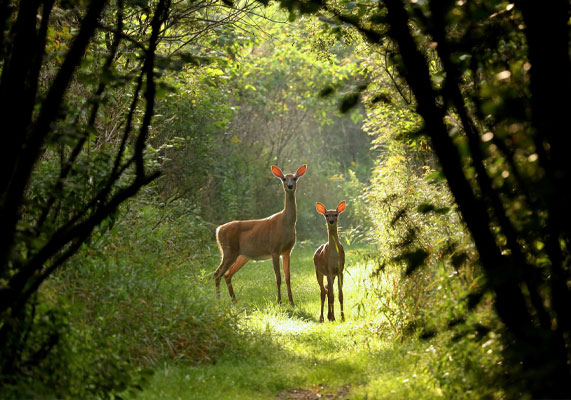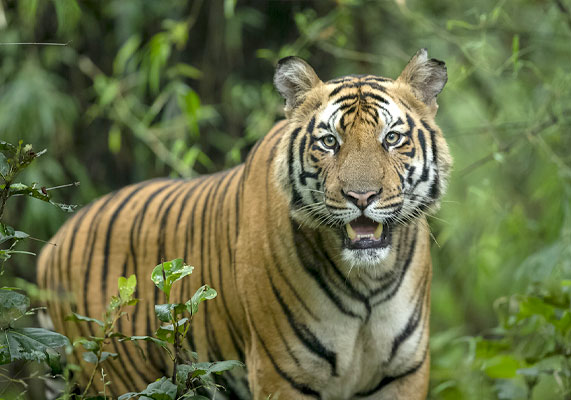Biodiversity
According to a Forest Survey of India report released in 2012, Odisha has 48,903 km2 of forests which cover 31.41% of the state's total area. The forests are classified into: dense forest (7,060 km2), medium dense forest (21,366 km2), open forest (forest without closed canopy; 20,477 km2) and scrub forest (4,734 km2). The state also has bamboo forests (10,518 km2) and mangroves (221 km2). The state is losing its forests to timber smuggling, mining, industrialisation and grazing. There have been attempts at conservation and reforestation.
Simlipal National Park is a protected wildlife area and tiger reserve spread over 2,750 km2 of the northern part of Mayurbhanj district. It has 1078 species of plants, including 94 orchids. The sal tree is the primary tree species there. The park has 55 mammals, including barking deer, Bengal tiger, common langur, four-horned antelope, Indian bison, Indian elephant, Indian giant squirrel, Indian leopard, jungle cat, sambar deer, and wild boar. There are 304 species of birds in the park, such as the common hill myna, grey hornbill, Indian pied hornbill and Malabar pied hornbill. It also has 60 species of reptiles, notable among which are the king cobra, banded krait, and tricarinate hill turtle. There is also a mugger crocodile breeding program in nearby Ramtirtha. The Chandaka Elephant Sanctuary is a 190 km2 protected area near the capital city, Bhubaneswar. However, urban expansion and over-grazing have reduced the forests and are driving herds of elephants to migration. In 2002, there were about 80 elephants. But by 2012, their numbers had been reduced to 20. Many of the animals have migrated toward the Barbara reserve forest, Chilika, Nayagarh district, and Athagad. Some elephants have died in conflicts with villagers, while some have died during migration from being electrocuted by power lines or hit by trains. Outside the protected area, they are killed by poachers. Besides elephants, the sanctuary also has Indian leopards, jungle cats and chitals.




The Bhitarkanika National Park in Kendrapara district covers 650 km2, of which 150 km2 are mangroves. The Gahirmatha Beach in Bhitarkanika is the world's largest nesting site for olive ridley sea turtles. In 2013 the Indian coast guard started Operation Oliver to protect the endangered sea turtle population of the region. Other major nesting grounds for the turtle in the state are Rushikulya, in Ganjam district, and the mouth of the Devi river. The Bhitarkanika sanctuary is also noted for its large population of salt-water crocodiles. In winter, the sanctuary is also visited by migratory birds. Among the species of birds spotted in the sanctuary are the black-crowned night heron, darter, grey heron, Indian cormorant, Oriental white ibis, purple heron, and sarus crane. The possibly endangered horseshoe crab is also found in this region.
Chilika Lake is a brackish water lagoon on the east coast of Odisha with an area of 1,105 km2. It is connected to the Bay of Bengal by a 35-km-long narrow channel and is a part of the Mahanadi delta. In the dry season, the tides bring in salt water. In the rainy season, the rivers falling into the lagoon decrease its salinity. Birds from places like the Caspian Sea, Lake Baikal, other parts of Russia, Central Asia, South-East Asia, Ladakh and the Himalayas migrate to the lagoon in winter. Among the birds spotted there are Eurasian wigeon, pintail, bar-headed goose, greylag goose, flamingo, mallard and Goliath heron. The lagoon also has a small population of the endangered Irrawaddy dolphins. The state's coastal region has also had sightings of finless porpoise, bottlenose dolphin, humpback dolphin and spinner dolphin in its waters.